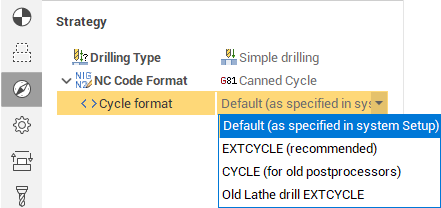Lathe hole machining operation

The operation is designed for the drilling, boring, centering and tapping of the axial hole by the fixed axial tool when the main rotational movement makes the workpiece. So the operation restricted to machine only axial holes.
The hole to machine with its top and bottom levels you can define in the Job assignment window. In the same window the user can access the function of automatic recognition of holes in the model.

 — Create hole by center point
— Create hole by center point — Create hole by coordinates input
— Create hole by coordinates input — Automatically recognize holes in the part
— Automatically recognize holes in the part — Create holes array by pattern
— Create holes array by pattern — Properties of the selected items
— Properties of the selected items — Delete selected items
— Delete selected items
The holes added in this window appears in graphical window too. The levels of each hole you can edit directly on the screen with mouse also.
Use operation parameters dialog that is accessed by the ![]() parameters button on the <Tool> tab to select the tool for hole machining.
parameters button on the <Tool> tab to select the tool for hole machining.
Use <Feeds/Speeds> tab to setup cutting conditions: spindle revolution rate, cooling, feed rates for different motion modes(approach, retract, work feed and the like). Auxiliary transitions (non-cut transitions) are performed either with rapid feed rate or with work feed rate, this option is controlled by the <All non-cut feeds as rapid> check-box. Work feed rate motion for non-cut transitions is useful than machining non-orthogonal plane holes as some NC-systems control only the start and end positions of the tool when performing rapid motions.
Hole machining mode and other additional parameters are set in the properties inspector at the bottom left part of main window.

The dialog interface and parameter list are changing according to selected <Drilling type>.
NC code format defines the way of the g-code output:
<Long Hang>. All motions are output as the elementary command (lines and circle arcs). Use this option for special cases then machine's CNC-system can't form canned cycle movements (for example, some CNC-systems do not support canned cycles at non-orthogonal planes).
<Canned cycle>. The cycles is output. Every cycle contains a full set of motions to machine the hole within itself. The way of machining depends on the used CNC. See your CNC manual for the detailed information.
The <Safe distance> parameter defines dimension from the upper level of the hole to the point on the hole axis. The feedrate is switched in this point from the rapid to the work one. So this distance is used to avoid the collision on the rapid feed.
<Return distance> defines the <Return point> under the hole. It is the distance from the upper hole level to the point on the axis. This is the start and end point of the hole machining cycle.
For compatibility with older versions of postprocessors the system provides the ability to change the output format of the drilling cycle (when not expanded toolpath output method is used). In the properties inspector for the hole machining operation is a corresponding parameter <Cycle format>.
This parameter can have the following values.
<Default (as specified in system Setup)>. The cycle format will be used, which is specified in the system settings. The default setting in the system Setup window has a value EXTCYCLE.
<EXTCYCLE (recommended)>. The new format of the cycle EXTCYCLE will be used. This cycle has an advanced set of parameters, including all machining strategies that are implemented in the system, and allows a realistic simulation of the tool movements according to the chosen strategy.
<CYCLE (for old postprocessors)>. The old format of the cycle CYCLE will be used. This cycle cannot be used for some of the strategies available in the system (e.g., hole pocketing or machining by spiral). Also this cycle simulates any machining strategy only as a simple movement to the lower level of the hole. This format is required for compatibility with older versions of postprocessors, where EXTCYCLE technological command processing routine is not implemented.
<Old Lathe drill EXTCYCLE>. EXTCYCLE command will be used in the form as it was in old Lathe drilling operation.
See also: